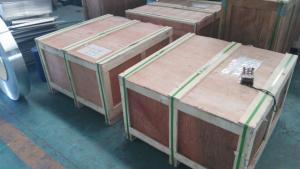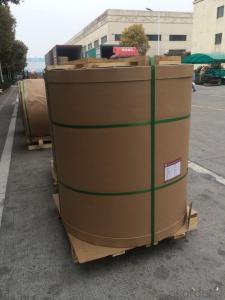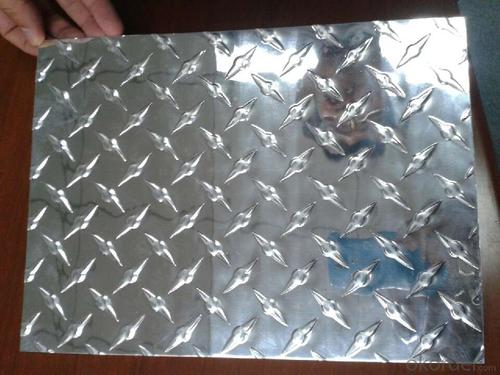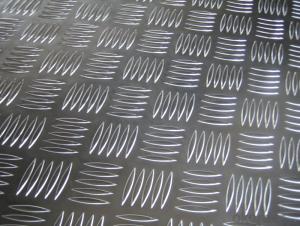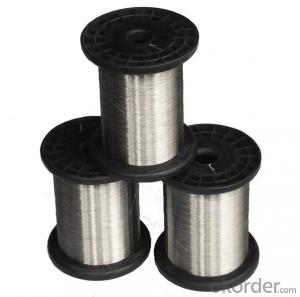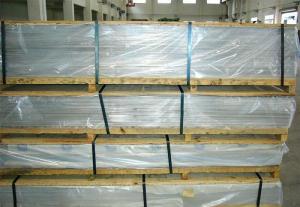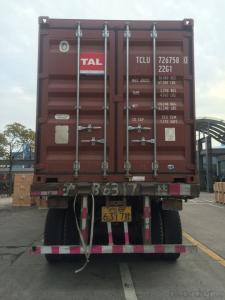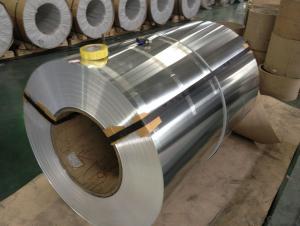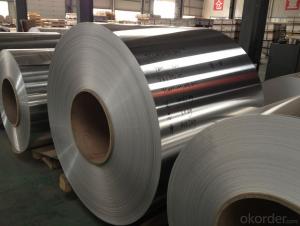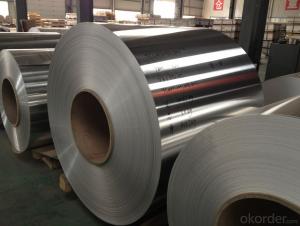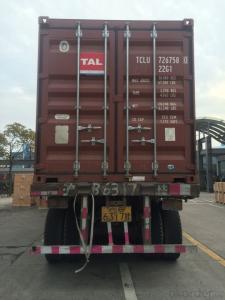Aluminum Sheets Vermont - Aluminium Cold Sheet in Warehouse with Many Stocks Now
- Loading Port:
- Qingdao
- Payment Terms:
- TT OR LC
- Min Order Qty:
- 1 m.t
- Supply Capability:
- 2000 m.t/month
OKorder Service Pledge
OKorder Financial Service
You Might Also Like
Specification
1.Structure of Product Description
aluminum sheet and hot drawn aluminium plate is widely used in the field of decoration and industrial field, etc.
There are many different grades, such as: 3000 series, 5000 series, 6000series,7000 series, 8000 series,etc. The detailed alloy number and temper are as follows: 1010, 1050,1060,1100, 2024, 3003, 3005, 3105, etc.
The temper is include H14, H22, H24, H44,H114,etc.
2. Main features of the product
a.Competitive price
c. Shortest service.
3. Image.

4. Product detailed sizes:
1000mm*2000mm,1220*2440mm,1500*3000mm,1219mm*2438mm,etc.
5. FAQ:
What is the quality standard?
---Usually our standard is GB3880-2006 or others.
What is the width range level?
---It is from 500mm to 6000mm, etc.
What is the MOQ for your products yet?
---Normally it is about 9 tons/each size.
How many tons did you export in one year
Japan, UAE,Singapore,Fiji,Indonesia,Canada, Vietnam,Turkey,etc.
---Normally they are aluminum sheet,small-5-bar aluminium checkered sheet, big-5-bar checkered aluminium plate, mirror finish aluminium sheet, aluminum casting coil, etc.
- Q: Can aluminum sheets be used for air conditioning systems?
- Yes, aluminum sheets can be used for air conditioning systems. Aluminum is a popular material choice for air conditioning components due to its excellent thermal conductivity, lightweight nature, and resistance to corrosion. It is commonly used for manufacturing air conditioner coils, fins, and heat exchangers.
- Q: How are aluminum sheets different from aluminum plate?
- Aluminum sheets and aluminum plates are two forms of aluminum metal that differ primarily in terms of thickness. Aluminum sheets are typically thin, flat pieces of aluminum that are less than 6mm thick. They are commonly used in applications where lightweight and flexibility are important, such as in the construction of aircrafts, automobiles, and electronic devices. On the other hand, aluminum plates are thicker and heavier than sheets, typically measuring 6mm or more in thickness. Plates are often used in applications that require strength and durability, such as in the construction of heavy machinery, structural supports, and marine equipment. While both sheets and plates are made from aluminum, their distinct thicknesses make them suitable for different purposes.
- Q: Are aluminum sheets suitable for roofing systems?
- Indeed, aluminum sheets prove to be an appropriate option for roofing systems. The durability, lightweight composition, and corrosion resistance of aluminum render it a favored choice for rooftops. Moreover, aluminum possesses fire-resistant properties and can endure harsh weather conditions, including strong gusts and heavy precipitation. With their long lifespan and minimal upkeep requirements, aluminum roofing sheets present a financially sound choice over time. Furthermore, the highly reflective nature of aluminum aids in reducing energy expenses by maintaining cooler indoor temperatures in hot climates. In summary, aluminum sheets emerge as a dependable and effective preference for roofing systems.
- Q: Can aluminum sheet be used for insulation?
- Aluminum sheet can be used for insulation, but it is not as effective as other insulation materials, such as fiberglass or foam. Aluminum has a low thermal conductivity, meaning it is a poor conductor of heat. However, it does not have good insulating properties on its own because it does not provide much resistance to heat flow. In order to use aluminum sheet for insulation, it is commonly combined with other insulating materials to enhance its effectiveness. For example, aluminum foil is often used as a radiant barrier in buildings to reflect heat and reduce the amount of heat transferred through walls and roofs. Overall, while aluminum sheet can contribute to insulation, it is usually used in conjunction with other materials to provide better thermal insulation.
- Q: What are the different surface finishes for aluminum sheets in the automotive industry?
- Aluminum sheets in the automotive industry have a variety of surface finishes available. These finishes are applied to enhance the appearance, durability, and corrosion resistance of the sheets. Common surface finishes for aluminum sheets in the automotive industry include: 1. Mill Finish: This is the most basic finish for aluminum sheets. It is achieved by extruding the aluminum and passing it through a rolling mill. Mill finish aluminum sheets have a smooth, shiny surface but may have slight imperfections or scratches. 2. Brushed Finish: Also known as satin finish, this texture is created by brushing the surface with abrasive materials. It gives the aluminum a unique grain pattern and a slightly matte appearance. 3. Anodized Finish: Anodizing is an electrochemical process that forms a protective oxide layer on the surface of the aluminum sheet. Anodized aluminum sheets are highly resistant to corrosion and wear. They can be dyed in various colors, offering a decorative and vibrant finish. 4. Polished Finish: Polished aluminum sheets have a reflective, mirror-like surface achieved through mechanical polishing or chemical processes. This finish is often used for decorative purposes, providing a high-end, glossy appearance. 5. Textured Finish: Textured aluminum sheets have a pattern or texture embossed onto the surface. This finish is commonly used for aesthetic purposes, adding visual interest and helping to conceal scratches or imperfections. 6. Painted Finish: Aluminum sheets can be painted to provide extra protection and improve aesthetics. Painted finishes can be customized to match the desired color or design scheme of the automotive industry. This finish offers excellent corrosion resistance and durability. The choice of surface finish for aluminum sheets in the automotive industry depends on the specific application, desired appearance, and functional requirements. Each finish has its own advantages and contributes to the overall performance and visual appeal of automotive parts or components.
- Q: This question asks for the various types of surface treatments or coatings that can be applied to aluminum profiles to enhance their properties or appearance.
- <p>Aluminum profiles can be coated with several types of finishes to improve their aesthetic appeal, durability, and corrosion resistance. The common types include: 1) Anodizing, which creates a protective oxide layer on the aluminum surface; 2) Powder coating, where a dry powder is electrostatically applied and then cured under heat; 3) Electrophoretic coating, a method where charged particles adhere to the aluminum and then harden; 4) PVDF (Polyvinylidene Fluoride) coating, known for its excellent weather resistance and durability; 5) Thermal spraying, where a coating material is melted and sprayed onto the aluminum surface; and 6) Painting, which can be done through various methods such as airless spray or dip coating. Each type of coating serves different purposes and has its own set of advantages and applications.</p>
- Q: You are probably think wtf. Lol, so I just got a Mac and I HATE its keyboard! Also, I have been looking at Fallout 3, and I think its looks amazing! Here is my question: Should I get the new aluminum keyboard for my Mac or Fallout 3? I have $60 to spend and I have found a place to get one or the other for under $60. I could also get on Ebay and get BOTH! Which one/option should I do?
- Is okorder /... As for the game, you can just get that off OKorder.
- Q: An aluminum clock pendulum having a period of 1.00 s keeps perfect time at 20 degrees celcius. (A) When placed in a room at a temperature of -5.0 Celcius, will it gain or lose time? (B)How much time will it gain or lose every hour.
- A for a swinging pendulum period T =2pi*√(L/g), where L is length of the pendulum, g=9.8m/s^2; metals shrink when cooled, so period will decrease, number of ticks per hour will increase, the clock will hurry up; B? period at t1°=20C° is T1=2pi*√(L1/g); ? period at t2°=-5C° is T2=2pi*√(L2/g); ? the law of linear extension says L2/L1= 1+s*Δt°, where s=23.1·10-6 (1/К°) is specific linear extension of aluminum, Δt°=t2°-t1°; ? thus T2/T1 =√(L2/L1) = √(1+s*Δt°) =f1/f2, where frequency f1= 1 Hz at 20C° or 3600 ticks per hour, hence frequency at -5C° is f2= f1/√(1+s*Δt°); therefore instead of 3600 ticks per hour the clock will do 3600/√(1+s*Δt°) ticks per hour; thus it will gain 3600*(1/√(1+s*Δt°) –1) = = 3600*(1/√(1 -23.1·10-6 *25°) –1) = 1.04 s/hour;
- Q: Are 101 aluminum sheets suitable for chemical processing environments?
- Chemical processing environments can utilize 101 aluminum sheets effectively. These sheets are made from a commercially pure aluminum alloy known as 101 aluminum, which boasts commendable resistance to corrosion and exceptional weldability. They find extensive application in settings demanding high corrosion resistance, such as chemical processing plants. Moreover, the protective measures of applying a coating or undergoing an anodizing process serve to augment their chemical resistance. In summary, 101 aluminum sheets are an ideal option for chemical processing environments, offering both corrosion resistance and durability when exposed to diverse chemicals.
- Q: Can aluminum sheets be roll-formed?
- Yes, aluminum sheets can be roll-formed. Roll forming is a process in which a continuous strip of metal, in this case, aluminum, is fed through a series of rollers to gradually shape it into a desired profile or shape. Aluminum is an ideal material for roll forming due to its malleability and ductility, allowing it to be easily bent, curved, and formed into various shapes. It is commonly used in industries such as construction, automotive, and aerospace for applications that require lightweight yet durable components.
Send your message to us
Aluminum Sheets Vermont - Aluminium Cold Sheet in Warehouse with Many Stocks Now
- Loading Port:
- Qingdao
- Payment Terms:
- TT OR LC
- Min Order Qty:
- 1 m.t
- Supply Capability:
- 2000 m.t/month
OKorder Service Pledge
OKorder Financial Service
Similar products
Hot products
Hot Searches
Related keywords

